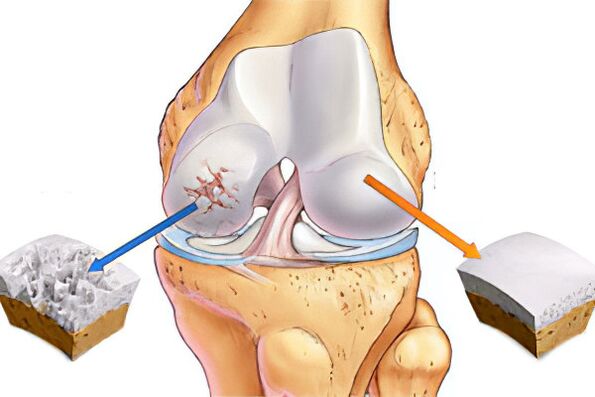
Arthrosis is an articulations disease, considered distributing and associated with the slow destruction of the cartilage within the joint.With osteoarthritis, for a long time, changes occur, restructuring the joint ends of the bones, the inflammatory processes are underway and the degeneration of the periosematic tissues occurs.Such a thing as "osteoarthritis" also includes a very large group of joint diseases of an inflammatory degenerative nature, which have different causes and similar mechanisms of their development.
Arthrosis is considered the most common joint disease in the world, according to statistical data in one grade or another, up to 80% of the population of the globe suffer from osteoarthritis.The disagreements of this type are very common and are in third place, after oncology and cardiovascular diseases.
The probability of developing osteoarthritis increases many times.The disease also affects men and women, the exception is only the osteoarthritis of the joints between phalanx, since it shows more frequently in women.Arthrosis surpasses people to the working age: from 30 years and every year, the number of sick people constantly and constantly increases.
The causes of osteoarthritis
Arthrosis develops due to metabolic disorders in the joint, which in turn leads to the fact that the cartilage begins to lose elasticity.This can be facilitated due to complete or partial loss of the composition of the cartilage of proteoglycans, this happens, as a rule, due to rather deep cracks in the cartilage itself.The loss of proteoglycans can occur for another reason: due to the failure of their production by joint cells.
The following reasons can affect the occurrence and development of osteoarthritis:
- Order previous injuries.It can be dislocations, bruises, fractures, ligaments and other damages.
- Metabolic disorders.
- Excess body weight, which leads to additional loads in the joints.
- The inflammatory process in the joints is acute purulent arthritis.
- Elderly age.
- Low power quality.
- Hypothermia.
- Autoimmune diseases: red lupus, rheumatoid arthritis.
- General body poisoning.
- Frequent colds.
- Specific inflammation: syphilis, tuberculosis, tick encephalitis, gonorrhea.
- Thyroid diseases.
- Violation of blood coagulation (hemophilia).
- Pertes's disease is a violation of the blood supply to the femoral head.
In addition, at risk, in the near future, a disease such as osteoarthritis, are people whose professions are: mason, miner, fisherman, blacksmith, metallurgical and other areas of activity related to the increase in physical work.
Symptoms of osteoarthritis
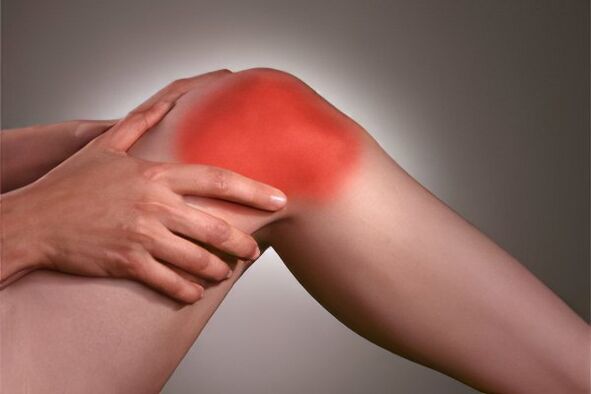
Symptom of osteoarthritisThere is pain in the articulation load, which decreases when the resting joint;Reduction of joint mobility, crunch, a sensation of muscle tension in the joint.The joint affected articulation by osteoarthritis can increase, and over time is deformed.
Consider the following 4 large groups of osteoarthritis symptoms:
- Pain.The presence of pain is the first sign of arthrosis of the joints.It can be assumed that with any damage, similar sensations occur, but with osteoarthritis the pain has some characteristics.First, this is the appearance of sudden pain or significant discomfort during movements.It will be located in the place where the painful articulation is located.When a person stops the movement and enters a state of rest, the pain passes.At night, a person practically does not experience unpleasant sensations, unless during the blows of the body, find the optimal position: the patient sleeps calmly.The pain appears during the break only in the stage of progression of the disease, they have some similarity to dental bastards when a person cannot reconcile sleep.They are closer to 5 o'clock.So, at the beginning of pain, there is practically no pain, you can only feel with load or palpation, over time the suffering of a person intensifies, and the joint requires more and more rest periods.Then, life becomes completely to torture: the hyaline cartilage is thinned, the bone is exposed, the osteophytes begin to grow.Acute pain torments almost constantly, even more intensifying in bad weather and full moon.
- Crunch.An equally indicative symptom of osteoarthritis is the presence of crunch.It becomes audible due to the fact that the softness of the rotation of the bones in the joint is reduced, rub each other, as a result from which a characteristic sound arises.You can listen to a crunch with other diseases, and even when the joints are healthy.But it is precisely such a crunch that is distinguished by its "dry" sound.The more the disease progresses, the brighter the sound becomes.In addition, if a crunch is heard, then pain will be felt.This is what makes it possible to distinguish the sound made by the joints with osteoarthritis of the usual harmless click.
- Reducing joint mobility is another characteristic symptom of osteoarthritis.In the initial stage, this phenomenon does not bother the patient, but with the progression of osteoarthritis, the germination of bone neoplasms leads to the fact that the muscles are spasmodic and the joint gap disappears almost completely.This is the cause of limb immobility in the destination.
- Joint deformation.Its modification is determined by the fact that osteophytes grow on the surface of the bones and the synovial fluid arrives.Although deformation is one of the last symptoms, when osteoarthritis has hit the joint to a large extent.
The course of the disease is characterized by exacerbation stages and remission stages.This significantly complicates the independent diagnosis of osteoarthritis, depending only on their own sensations.Therefore, it is necessary to seek clarification from the doctor's diagnosis.
Degree of osteoarthritis
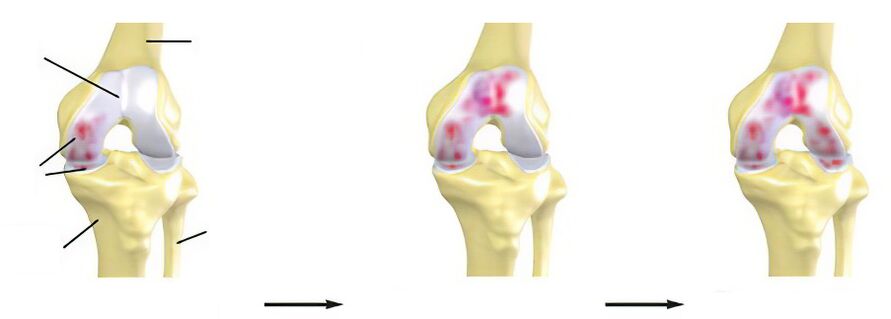
Arthrosis is characterized by degenerative distributing changes in the joints that will persecute a person in the form of chronic disease.The result of such destruction is the defeat of the cartilage joint, the pathological changes in its capsule and the synovial cover, in ligaments and bone structures.
It is usual to distinguish between three degrees of osteoarthritis, which characterize the different gravity of the course of the disease and have several symptoms.
1 degree of osteoarthritis
In the first stage of the development of osteoarthritis, there are no serious changes in joint morphology.Only the composition of the synovial fluid is altered.Supply the articular tissue with worse nutrients, so the cartilage loses its previous resistance to the charges that are familiar with it.This leads to the fact that cartilage fabrics are inflamed, a person has pain.
The patient may complain about insignificant stiffness in the joints, but most of the time he does not pay attention to this feeling, attributing such violation of health changes in the climate, he has uncomfortable, etc.
Sometimes you can hear a weak crunch in the area of the affected joint.The pain can hurt.If the disease is diagnosed at this stage, it will be possible to deal with conservative methods.
2 degrees of osteoarthritis
The second stage of osteoarthritis is accompanied by the destruction of the cartilage.Bone growth appear at the edges of the joint.The more intense the load is, the stronger the cartilage fabric of the joint.
A person experiences constant pains, to whom he gets used to.Inflammation now calms down and then aggravates again.
The muscles surrounding the joints will lose their previous functions, but most of the time such disorders are weak or moderate.Therefore, at this stage, a person can refuse to visit the doctor.
After a short load on the legs, a person can experience fatigue.At the same time, the painful pain in the joints becomes sharp.Cryst during the movement intensifies, which is explained by bone growth.
It is in the second degree of osteoarthritis development in the joints that the deformation process begins, so you should definitely seek medical help.
3 degrees of osteoarthritis
The third degree of osteoarthritis is the most serious.The cartilage of the articulation of the affected joint is not only diluted, but also began to collapse, and the pathological spotlights are already quite large.The Board is very deformed, which affects the normal axis of the limb.
The ligaments that surrounded the joint previously lose their functional activity, become short, which affects the mobility of the arms or legs.
During this period, a person has contractures and subluxation.The muscles surrounding the joint are shortened and stretched, are difficult to contract.The articulation itself and nearby fabrics suffer from insufficient nutrition.
A person is tormented by severe pain, is acute and sharp.Even at rest, the patient experiences significant discomfort.The third degree of osteoarthritis is associated with the risk of complete loss of human capacity.
Types of osteoarthritis
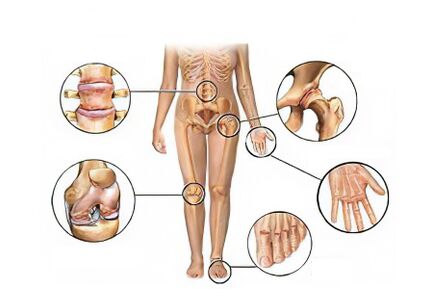
Depending on the cause of osteoarthritis, a disease with unclear etiology is distinguished, that is, idiopathic osteoarthritis.Most of the time, it is diagnosed in people over 40.There is also secondary osteoarthritis, which occurs in the context of obvious causes (after injury, with joint inflammation, with endocrine diseases, etc.).
In addition to the fact that osteoarthritis is classified depending on the cause of its occurrence, the following varieties of the disease are distinguished:
- Knee osteoarthritis or gonarrosis.This is the most common type of disease.At the same time, knee joints suffer.Pathology is more frequently diagnosed in people with excess body weight, in the context of metabolic deterioration in the body, as well as due to stress.The disease develops over the years, in its late stage, the knee completely loses its mobility.
- Ankle osteoarthritis.In this type of disease, the ankle joint is affected.The disease develops in the context of the lesions, with the stretching of the ligaments, due to the available dysplasia, the gout and the diabetes.Sometimes, the cause of pathology is rheumatoid arthritis.Most of the time, ankle osteoarthritis is diagnosed in people whose work is associated with excessive loads in this area: in dancers, athletes, in women who wear high tub shoes.
- Shoulder osteoarthritis.The main reason for the pathology is considered congenital defects of the shoulder joint or excessive loads.The risk group includes carriers, plasters and people who are occupied with hard manual work.This also includes the osteoarthritis of the elbow joint.
- Hip joint osteoarthritis or coxarche.This is one of the great varieties of pathology.The main reason are age -related changes in joint tissues.The risk group includes people over 40.
- Cervical osteoarthritis.The reasons that can lead to the development of this pathology: insufficient mobility of the cervical column, obesity and injuries.The risk group includes people participating in sedentary work.In addition to the main symptoms of osteoarthritis in the form of pain and restriction of joint mobility, patients have dizziness, headaches and sometimes even loss of consciousness.This is due to the participation of the vertebral artery in the pathological process, which feeds the brain.
- Osteoarthrosis of the hands and fingers.In this case, the doll joint is damaged, fingertips, etc.More frequently, women who entered during the menopause period suffer from pathology.
- Spondilartrosis in which the joints and cartilage of the spine suffer.The disease develops more frequently in age people, after 65 years.Women mainly suffer from it, which is explained by a decrease in the estrogen level after the climax that has come.
- In potoarthrosis.This is a disease of a degenerative nature in which the peripheral joints, ligaments and tendons suffer.The column joints can be involved in the pathology.
Arthrosis complications
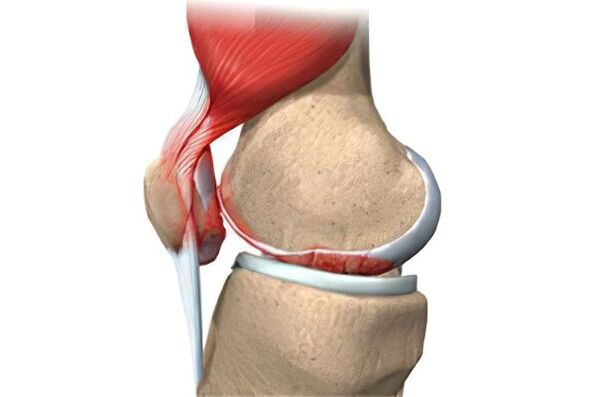
If osteoarthritis does not provide adequate attention, do not treat it over time and correctly, this can lead not only to the complete destruction of the sick joint, but also to a change in the biomechanics of the spine, so it may appear hernias on intervertebral discs and the development of osteoarthritis in other healthy joints.The complication of arthrosis of the joints is better not to allow.
The following pathologies are distinguished as the main complications of osteoarthritis:
- Destruction of the joint.
- Joint deformation.
- The impossibility of carrying out movements.
- Patient disability.
- Violation of the biomechanics of the column and other joints.
- Hernias of intervertebral discs.
- Reducing the patient's life standard.
Diagnosis of osteoarthritis
To make a diagnosis, the doctor should interview and inspect the patient.Then he will name an X line of the affected joints.
X -Ray images are made more frequently in 2 projections.The study allows you to visualize the distributing changes in the tissues, the damage to the cartilage and the adjacent bones.The articular gap in patients with osteoarthritis is reduced, the bone site is deformed, bone growth, osteophytes can leave it.Sometimes, the articulation itself loses stability, which leads to dislocations.
The first sign of osteoarthritis, which can be visualized in an X -rays, is the presence of osteophytes.First, the edges of the joint surface simply become acute.In the future, they thick, and then appear on them and the peaks.The joint gap is already becoming as the pathology progresses.
Depending on the resulting radiological image, the doctor can make the following diagnosis (the Kellgren-Lawrence classification is taken as a base):
- Arthrosis is doubtful.It is not possible to determine the degree of narrowing of the joint gap, but they are small osteophytes.
- Soft osteoarthritis, in which osteophytes are well visualized, but there are doubts about the narrowing of the articular gap.
- Moderate osteoarthritis is diagnosed when the joint gap is clearly reduced and osteophytes are clearly visible.Sometimes bone deformations are found.
- Severe osteoarthritis is accompanied by significant narrowing of the articular gap and the formation of large osteophytes.The articulation will be deformed.
If the doctor needs more information about the status of the joint, he can lead the patient to pass the TC, arthroscopy or magnetic resonance.To evaluate the quality of the synovial fluid, joint puncture is performed.
Treatment methods

It is better to treat painful joints at an early stage, the treatment itself must be pathogenetic and complex.The essence of the treatment is to eliminate the causes that contribute to the development of this disease, it is also necessary to eliminate inflammatory changes and restore the functions that have previously been lost.
The integral treatment of osteoarthritis includes drugs that have anti -inflammatory and analgesic properties, physiotherapeutic procedures should also be carried out, which have an analgesic effect on the joints.If the treatment is performed in a SPA resort, then it consists of climatic conditions that act favorably on the joints, as well as in the use of mineral waters and mud.
The treatment of osteoarthritis is based on several basic principles:
- Damaged joints should be removed from excessive load.If possible, during treatment, it should usually be minimized.
- After the established orthopedic regime.
- Physiotherapy exercise classes.
- The physiotherapy passage, which includes a magnet and electrotherapy, shock waves, as well as laser therapy.
- Sanatorium treatment.To do this, it is necessary once a year, on the recommendation of a doctor, suffers a course treatment in specialized resorts.
- SATURO of the joint with oxygen, or the oxygen therapy of the joint called SO inside.
- Drug therapy.
- Inside, the blockade of the bones, as well as the decompression of Metrophyse.
- Rational nutrition approach.
Physiotherapeutic treatment
You can deal with osteoarthritis using physiotherapeutic treatment methods.
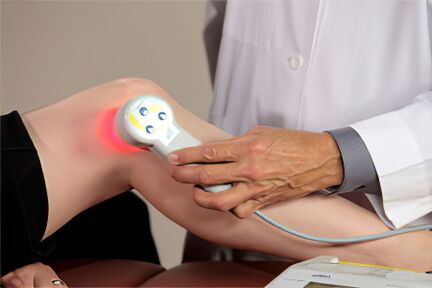
These include:
- UVT.Shock wave therapy allows us to get rid of osteophytes, which are bone processes.It is they who become the main cause of pain.The waves soften these growth and after a while they are absorbed.At the same time, the power of the improvement joint, the metabolic processes are normalized.This procedure is effective only in the early stages of disease development.In addition, only a doctor can designate it, since it has many contraindications.
- Mioestimulation.The method is based on muscle stimulation by electrical impulses.The procedure is shown for the treatment of bed prostrated patients who are forced to adhere to bed rest after the lesion.This method is not prescribed very frequently for osteoarthritis, although it allows it to normalize blood flow in the problem of the problem and increase muscle tone, which allows you to bring the deadlines for the restoration of the joints.
- Phonoforesis.In this method of treatment, the joint is exposed to waves and ultrasound drugs.The effect of medications increases, since they will be delivered "exactly at the destination", and the cells will learn better.
- Ozonotherapy.This method implies the introduction of a gas mixture in the joint.The patient disappears, inflammation decreases, joint mobility is normalized and blood circulation improves.The treatment is carried out in courses.Its duration depends on the severity of the pathology flow.
Surgical types of treatment
When it is not possible to deal with the disease with conservative methods, the patient is aimed at the operation.
Surgical intervention methods include:
- Puncture performance.This is not only a therapeutic method, but also a diagnostic method.During its implementation, the needle is inserted into the Board, taking a small amount of liquid.In the future, it is sent for analysis.This method allows you to eliminate the articulation load, as well as deliver medications, for example, corticosteroids.
- Arthroscopy.At the same time, an arthroscope is introduced into the joint, for which several small cuts are made in the skin.This procedure allows to evaluate the condition of the joint from the inside.During arthroscopy, the doctor can eliminate unnecessary cartilage, thus delivering a person from pain.
- Near joint osteotomy.The operation is reduced to the fact that the bones of the joint are slightly sawn and fixed in the correct position.This allows you to reduce the load in the defeat area, as well as save a person from pain.Although the procedure is effective enough, they rarely resort to it, since it is carried out under anesthesia and requires a long recovery period.
- Replace your own articulation with a prosthesis.Endoprothetics is used if the joint is very deformed and cannot be restored.This is a difficult operation that costs a lot of money.The prosthesis itself is made of materials such as: metal, ceramics, plastic.After the intervention, a person is restored for a long time, can suffer pain.Although it is often impossible to help patients with other methods, otherwise, a person may be completely immobilized.A high quality prosthesis can last 20 years.All this time, a person will not experience any problem with movement.
Drug treatment
Consider in more detail drug treatment:
- Anti -inflammatory drugs.Starting osteoarthritis therapy is integral, can slow down the course of the disease and greatly improve the quality of life.It is worth living in more detail in some treatment points.In particular, medication therapy includes in the initial stage: this is the elimination of pain, as well as the qualification of inflammatory processes that occur in the joints.
- Hormonal corticosteroids.When osteoarthritis is in the exacerbation stage, they are advisable hormonal corticosteroids.They are inserted into the Board.Externally, you can use a special patch, ointment or tincture, which are performed on the basis of burning pepper.
- The preparations destined to restore the cartilage and improve the high quality composition of the synovial fluid will not be superfluous.The course lasts a quite long period of time so far until the improvement occurs.
If the case is especially difficult, then the intake of narcotic analgesics can be prescribed.But they are used extremely rarely when the rest of the media did not bring the desired effect.
Adequate nutrition for osteoarthritis

Separately, it is worth living in nutrition during an exacerbation of the disease.There are also certain recommendations here: you cannot eat excessively, since this will contribute to the accumulation of additional pounds, but it is impossible to hunger, since the cartilage supply with important elements will break.The priority task, which faces the patient with excess weight, is their decrease.To do this, it is simply necessary to eliminate rapid carbohydrates from the diet, they are contained in all flour and sweet products.Alcohol falls under the ban and, first, beer.
There is absolutely no complaint about fish dishes: they can be used a lot, of course, in reasonable quantities.But you should not rely on their varieties too fat, since they have many calories, which means that extra pounds will not be long to arrive.
An important role in the treatment of osteoarthritis is assigned to a cold dish.Surprisingly, it is this dish that it is recommended to include all doctors in the diet.This meal will be a real warehouse of trace elements for the painful joints.The most important component on this dish is a collagen of natural origin.The body absorbs quite fast and is the basis of any connective tissue.Thanks to the regular consumption of the gelatin, good results can be achieved: the joints will become more mobile, the fabrics that cover their fabrics: elastic and cartilage and bones will gain strength.
Do not forget the regular intake of vitamins with food.For patients with osteoarthritis, vitamins B are especially relevant
Pyridoxin will help hemoglobin production."You can get it "eating bananas, nuts, cabbage and potatoes. It is worth putting it with vegetation and legumes. They will become a folic acid source. The liver, mushrooms, dairy products and eggs will be useful. They are rich in riboflavin.
When observing the treatment regime prescribed by the doctor, the disease can be removed and damaged tissues will begin to recover.



















